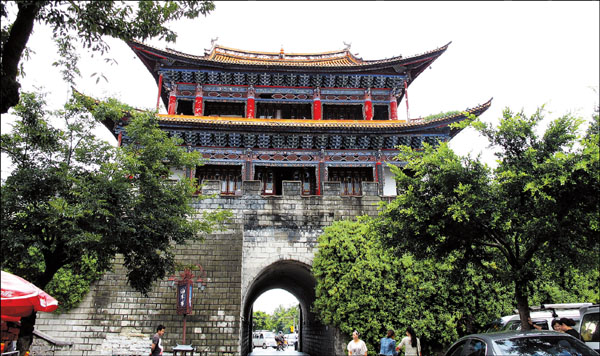 |
| North Gate of Dali ancient city. (Shanghai Daily) |
Critics say the ancient town of Dali in Yunnan Province has been spoiled by tourism. But Zhou Yubin finds that by staying close to the old wall and exploring the byways you can still have an authentic experience.
When I first stood on top of the Dali city wall, I found it hard to believe that the small ancient city below me had been the grand capital of a sprawling kingdom in southwestern Asia for hundreds of years.
Today the wall in Dali, Yunnan Province, is only 6 kilometers long — I could clearly see the far end and almost every building along the way. The original defensive wall encircling the city was built more than 600 years ago; the wall we see today is around 30 years old. It's around 6 meters thick, made of packed earth covered with bricks, standing around 8.3 meters high.
It was early morning, the city was still asleep, shops were closed and only a few tourists were wandering along the wall. In the drizzle and mist, the old white buildings in the ancient town suggested a sleeping swan.
Dali is an extremely popular — some say too popular — tourist destination in Yunnan, as is Lijiang City in the north of the province. Both are famous for their backpacker, hippie vibe, ethnic culture, crafts and food, as well as beautiful scenery and leisurely pace of life. Unlike Lijiang, Dali was a major political and economic center in southwestern China and Asia.
Some critics say the ancient city of Dali has lost its charm because of the overwhelming numbers of tourists, souvenir shops, faux-traditional structures, modern bars and loud music. But by staying close to the "old" city wall and exploring, you can still have a relaxing and authentic experience in unspoiled areas.
History
Southwestern China, including today's Guizhou, Yunnan and Sichuan provinces, is home to many ethnic minorities, such as the Bai and Yi peoples. Many tribes established their own territories and small administrative areas.
In AD 738, the rising Nanzhao Kingdom united five other kingdoms with the support of the Tang Dynasty (AD 618-907) government. The new Nanzhao Kingdom covered all of what is now Yunnan Province, part of Guizhou, and parts of the Tibet Autonomous Region, Myanmar and Vietnam. Dali City was the capital, da meaning big and grand, and li meaning administration or government.
The wish for grandeur came true. Nanzhao was the first united kingdom in southwestern China and the once-backward region began to flourish and catch up with prosperous Central China in the 8th and 9th centuries.
After the downfall of the Nanzhao Kingdom, the kingdom of Dali arose and flourished from AD 937 to 1253. It was an important military and political ally to the Song Dynasty (AD 960-1279). Since the Yuan Dynasty (1271-1368), the kingdom has belonged to the central government in today's Bejing City.

 2013 Colour Me Rad 5K run held in Canada
2013 Colour Me Rad 5K run held in Canada China's destroyer Qingdao sails out of Sydney Harbor
China's destroyer Qingdao sails out of Sydney Harbor Chinese tycoon aims to restore London's Crystal Palace
Chinese tycoon aims to restore London's Crystal Palace Worst flooding hits Yuyao, 70% of downtown area underwater
Worst flooding hits Yuyao, 70% of downtown area underwater Game for the brave: 'Spiders' in Yandang Mountains
Game for the brave: 'Spiders' in Yandang Mountains Hungarian wingsuit flyer confirmed dead in Zhangjiajie
Hungarian wingsuit flyer confirmed dead in Zhangjiajie Chinese screen goddesses from Beijing Film Academy
Chinese screen goddesses from Beijing Film Academy  Weekly Sports Photos
Weekly Sports Photos World's most amazing yacht on display in Guangzhou
World's most amazing yacht on display in Guangzhou Photo collection of Chinese Navy
Photo collection of Chinese Navy Photo story: Young tenants in Beijing
Photo story: Young tenants in Beijing Twins Culture Festival kicks off in Beijing
Twins Culture Festival kicks off in Beijing UNESCO world heritage site: Montale Tower
UNESCO world heritage site: Montale Tower Israeli drone crashes into Mediterranean, fragments recovered
Israeli drone crashes into Mediterranean, fragments recovered Fiber-optic wedding dress show shinning in Suzhou
Fiber-optic wedding dress show shinning in Suzhou Day|Week|Month